Aérospatiale SA 321 Super Frelon
| SA 321 Super Frelon | |
|---|---|
 | |
| A Super Frelon helicopter of the French Navy | |
| Role | Heavy-lift military Transport helicopter |
| National origin | France |
| Manufacturer | Sud Aviation Aérospatiale |
| First flight | 7 December 1962 |
| Introduction | 1966 |
| Status | In service with People's Liberation Army |
| Primary users | French Navy People's Liberation Army South African Air Force Iraqi Air Force |
| Produced | 1962-1981 |
| Number built | 110 |
| Developed from | SNCASE SE.3200 Frelon |
| Developed into | Avicopter AC313 |
The Aérospatiale (formerly Sud Aviation) SA 321 Super Frelon (Super Frelon – "Super Hornet") is a three-engined heavy transport helicopter produced by Sud Aviation (later Aérospatiale) of France. The helicopter is still in use in China where the locally produced version is known as the Z-8.
Development
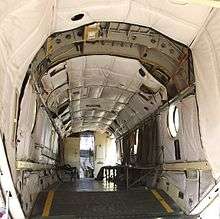
The SA.3210 Super Frelon was developed by Sud Aviation from the original SE.3200 Frelon. Sikorsky was contracted to supply the design of a new six-bladed main rotor and five-bladed tail rotor. Fiat supplied a design for a new main transmission. The first flight of the Super Frelon was 7 December 1962. A modified prototype Super Frelon helicopter was used on July 23, 1963 to break the FAI absolute helicopter world speed record with a speed of 217.7 mph (350.4 km/h).[1]
Both civilian and military versions of the Super Frelon were built, with the military variants being the most numerous by far, entering service with the French military as well as being exported to Israel, South Africa, Libya, China and Iraq.
Three military variants were produced: military transport, anti-submarine and anti-ship.
The transport version is able to carry 38 equipped troops, or alternatively 15 stretchers for casualty evacuation tasks.
The naval anti-submarine and anti-ship variants are usually equipped with navigation and search radar (ORB-42), and a 50-metre rescue cable. They are most often fitted with a 20 mm cannon, countermeasures, night vision, a laser designator and a Personal Locator System. It can also be refueled in flight.
Operational history
China
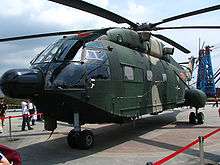
China acquired 12 SA 321 Super Frelon naval helicopters delivered from December 1975 to April 1977. These helicopters came in two variants: anti-submarine warfare (ASW) and search and rescue (SAR) versions. The Super Frelon was the first helicopter of the PLA to be capable of operating from the flight deck of surface vessels. China also produces the Super Frelon locally under the designation Z-8 (land- or-ship based ASW/SAR helicopter). The Super Frelon remains operational with the PLA Navy as of 2014.
Since the early 1980s, the Super Frelons have been frequently used by the PLAN for shipborne ASW and SAR operations. For ASW missions, the Z-8 is equipped with surface search radar and a French HS-12 dipping sonar while carrying a Whitehead A244S torpedo under the starboard side of the fuselage. The aircraft were also used to ferry supplies from replenishment ship to surface combatants, and transport marines from the landing ship to the shore. A naval SAR version called the Z-8S with upgraded avionics, searchlight, FLIR turret and a hoist flew in December 2004. Another rescue variant with dedicated medivac equipment on board was also developed for the Navy as the Z-8JH.
The Z-8A version was developed as an army transport variant and certified in February 1999. Two Z-8As were delivered to the Army for evaluation in 2001, but it decided to purchase more Mi-17V5s. Only one batch of about six Z-8A were delivered to the Army in November 2002, with the nose weather radar and side floats retained. Starting in 2007, the PLAAF also acquired dozens of upgraded Z-8Ks and Z-8KAs for SAR missions; they were equipped with a FLIR turret and a searchlight underneath the cabin, plus a hoist and a flare dispenser.
China also developed a domestic civil helicopter variant of the Z-8, the Avicopter AC313. The AC313 has a maximum takeoff weight of 13.8 tonnes and can carry 27 passengers, It has a maximum range of 900 km (559 miles).[2]
After the 2008 Sichuan earthquake, Z-8 helicopter production received a massive boost as it proved the helicopter's value in humanitarian missions. New engine acquisition and design changes were conducted to iron out existing issues affecting Z-8 for decades. The Chinese People's Armed Police ordered 18 Z-8 helicopters and in 2013 at least five helicopters were delivered, mainly appointed to forestry fire fighting units. In recent earthquake events, Z-8 helicopters performed multiple rescue and logistical missions.[3]
France
In October 1965 the SA 321G ASW helicopter joined the French Naval Aviation (Aeronavale). Apart from ship-based ASW missions, the SA321G also carried out sanitisation patrols in support of Redoutable-class ballistic missile submarines. Some aircraft were modified with nose-mounted targeting radar for 'Exocet' anti-ship missiles. Five SA321GA freighters, originally used in support of the Pacific nuclear test centre, were transferred to assault support duties.
In 2003, the surviving Aeronavale Super Frelons were assigned to transport duties, including commando transport, VertRep and SAR.
The SA321G Super Frelon served with Flotille 32F of the French Aviation navale, operating from Lanvéoc-Poulmic in Brittany in the Search and Rescue role. They were retired on 30 April 2010, replaced by two Eurocopter EC225 helicopters purchased as stop-gaps until the NHI NH90 came into service in 2011-12.[4][5]
Iraq
Designated the SA 321H, a total of 16 Super Frelons were delivered from 1977 to the Iraqi air force with radar and Exocets. These aircraft were used in the Iran–Iraq conflict and the 1991 Gulf War, in which at least one example was destroyed.
During the Iran–Iraq War, Iraq started using Super Frelon and its other newly purchased Exocet-equipped fighters to target Iranian shipping in Persian Gulf (see Tanker War). Two of the Iraqi Super Frelons were downed by Iranian fighters, one by a long-range shot of AIM-54A Phoenix by an F-14 Tomcat (during Operation Pearl) while under way over Persian Gulf, and one by an AGM-65A Maverick fired from an Iranian F-4 Phantom in July 1986, while attempting to take off from an oil rig.[6][7]
Israel
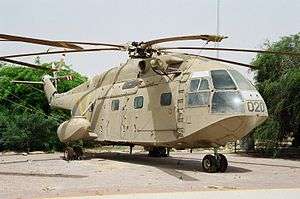
Israel ordered six SA 321K helicopters in 1965 to provide its air force with a heavy lift transport capability.[8] The first aircraft arrived on April 20, 1966, to inaugurate 114 Squadron operating out of Tel Nof. Another six were ordered the following year.[8] The Israeli military initially hoped to use the Super Frelons for deploying Panhard AML-90 light armoured cars in support of airborne operations, but this idea was dropped when tests revealed the helicopter could not handle the vehicle's combat weight.[9] Four helicopters had arrived by the start of the 1967 Six Day War, during which they flew 41 sorties. The aircraft saw extensive service during the War of Attrition, participating in such operations as Helem, Tarnegol 53 and Rhodes.[10]
The type was once again in service during the Yom Kippur War, following which Israel replaced the original Turbomeca Turmo engines with the 1,390 kW (1,870 shp) General Electric T58-GE-T5D engine. The Super Frelons also took part in the Israeli invasion of Lebanon in June 1982.[10] Due to their relatively high maintenance cost and poor performance capabilities compared to the IAF CH-53s, they were finally retired in 1991.
Libya
Six radar-equipped SA 321GM helicopters and eight SA 321M SAR/transports were delivered to Libya in 1980-81.[11]
South Africa
South Africa ordered sixteen SA 321L helicopters in 1965,[8] which were delivered by 1967 and adopted by the South African Air Force (SAAF)'s 15 Squadron.[12] At least two were deployed to Mozambique in support of Rhodesian military operations against insurgents of the Zimbabwe African National Liberation Army between 1978 and 1979.[12] Others were mobilised for evacuating South African paratroops from Angola during Operation Reindeer.[13] In August 1978, the South West African People's Organization sparked a major border incident between South Africa and Zambia when its guerrillas fired on an SAAF Super Frelon landing at Katima Mulilo from Zambian soil. The South Africans retaliated with an artillery strike, which struck a Zambian Army position.[13]
Syria
In October 1975, it was widely reported that Syria had ordered fifteen unspecified Super Frelons from France as part of an arms deal funded by Saudi Arabia.[14] While the Syrian Air Force did issue a requirement for fifteen of the specific aircraft, and recommended purchasing up to fifty, by 1984 the sale had still not materialized.[15]
Variants

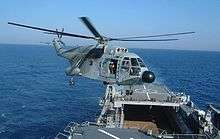
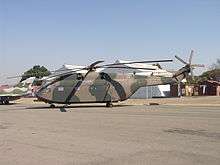
- SE.3200 Frelon
- Prototype transport helicopter powered by three 597 kW (800 hp) Turbomeca Turmo IIIB engines driving a four-bladed rotor of 15.2 m (50 ft) diameter. Two built, the first flying on 10 June 1958.[16]
- SA 321
- Preproduction aircraft. Four built.
- SA 321G
- Anti-submarine warfare version for the French Navy, it was powered by three Turbomeca IIIC-6 turboshaft engines; 26 built.
- SA 321Ga
- Utility and assault transport helicopter for the French Navy.
- SA 321GM
- Export version for Libya, fitted with Omera ORB-32WAS radar.
- SA 321H
- Export version for Iraq, it was powered by three Turbomeca Turmo IIIE turboshaft engines, fitted with Omera ORB-31D search radar, and armed with Exocet anti-ship missiles.
- SA 321F
- Commercial airline helicopter, powered by three Turbomeca IIIC-3 turboshaft engines, with accommodation for 34 to 37 passengers.
- SA 321J
- Commercial transport helicopter and accommodation for 27 passengers.
- SA 321Ja
- Improved version of the SA 321J.
- SA 321K
- Military transport version for Israel.
- SA 321L
- Military transport version for South Africa, fitted with air inlet filters.
- SA 321M
- Search and rescue, utility transport helicopter for Libya.
- Changhe Z-8
- Chinese built version with three Changzhou Lan Xiang WZ6 turboshaft engines.
- Changhe Z-8A
- Army transport.
- Changhe Z-8F
- Chinese built version with Pratt & Whitney Canada PT6B-67A turboshaft engines.
- Changhe Z-8AEW
- Chinese AEW helicopter with retractable radar antenna, AESA radar, 360 degree coverage, redesigned nose similar to the AC313, and FLIR.[17]
Operators
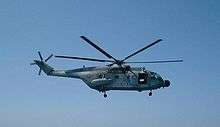
Military Operator
Former Operators
Specifications (Naval Super Frelon)
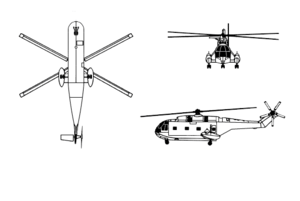
Data from Jane's All The World's Aircraft 1976-77 [29]
General characteristics
- Crew: five
- Capacity:
- 27 passengers or
- 15 stretchers
- Length: 23.03 m (75 ft 6⅝ in)
- Rotor diameter: 18.90 m (62 ft 0 in)
- Height: 6.66 m (21 ft 10¼ in)
- Disc area: 280.6 m² (3,019 ft²)
- Empty weight: 6,863 kg (15,130 lb)
- Max. takeoff weight: 13,000 kg (28,660 lb)
- Powerplant: Three × Turboméca Turmo IIIC turboshafts, 1,171 kW (1,570 hp) each
Performance
- Never exceed speed: 275 km/h (148 kn (170 mph))
- Maximum speed: 249 km/h (135 kn (155 mph))
- Range: 1,020 km (549 nmi (632 mi))
- Service ceiling: 3,150 m (10,325 ft)
- Rate of climb: 6.7 m/s (1,312 ft/min)
- Endurance: 4 hr
Armament
- Guns: 1× 20 mm (0.787 in) cannon (window-mounted)
- Missiles:
- 4× homing torpedoes in the ASW role or
- 2× Exocet missiles in the anti-ship role
See also
- Related development
- Aircraft of comparable role, configuration and era
- Related lists
References
- ↑ Taylor 1966, p. 63.
- ↑ "AC313 Civil Helicopter". AirForceWorld.com. Retrieved 5 April 2011.
- ↑ "Z8 Helicopter production boost from 2008". AirForceWorld.com. Retrieved 5 Oct 2014.
- ↑ Grolleau 2009, pp.56-60.
- ↑ Grolleau 2010, p.12.
- ↑ Williams, Anthony G.; Gustin, Emmanuel (2004). Flying Guns of the Modern Era. Marlborough: Crowood Press. p. 172. ISBN 9781861266552.
- ↑ Farrokh, Kaveh (2011). Iran at War, 1500-1988. Oxford: Osprey Publishing. p. . ISBN 9781780962214.
- 1 2 3 4 "Trade Registers". Armstrade.sipri.org. Retrieved 2014-11-20.
- ↑ The Israel Digest of Press and Events in Israel and the Middle East. The Israel Digest, 1966, Collected Issues Volumes 9-10.
- 1 2 Norton, Bill (2004). Air War on the Edge – A History of the Israel Air Force and its Aircraft since 1947. Midland Publishing. pp. 212–216. ISBN 1-85780-088-5.
- ↑ Donald and Lake 1996, p. 16.
- 1 2 Baxter, Peter (February 2013). SAAF's Border War: The South African Air Force in Combat 1966-89. Solihull: Helion and Company Ltd. p. 24. ISBN 978-1908916235.
- 1 2 Steenkamp, Willem. Borderstrike! South Africa Into Angola 1975-1980 (2006 ed.). Just Done Productions. pp. 132–226. ISBN 1-920169-00-8.
- ↑ The Syrian Arab Republic: a handbook, Anne Sinai, Allen Pollack, 1976, p. 101
- ↑ Hewish, Mark. Air Forces of the World: An Illustrated Directory of All the World's Military Air Powers. New York: Simon & Schuster, 1979. ISBN 0-671-25086-8. pp. 155-156.
- ↑ Stevens 1964, p.55.
- ↑ "Archived copy". Archived from the original on 2012-03-13. Retrieved 2012-03-19.
- 1 2 "World Air Forces 2013" (PDF). Flightglobal Insight. 2013. Retrieved 7 March 2013.
- ↑ "World's Air Forces 1990 pg. 50". flightglobal.com. Retrieved 7 March 2013.
- ↑ "Aéronautique Navale". Retrieved 7 March 2013.
- ↑ "V/STOL 1970". flightglobal.com. Retrieved 7 March 2013.
- ↑ "Olympic Airlines Sud Aviation SA-321 Super Frelon F-OCMF". airplane-pictures.net. Retrieved 7 March 2013.
- ↑ "Al Quwwa al Jawwiya al Iraqiya". Retrieved 7 March 2013.
- ↑ "World's Air Forces 1981 pg. 349". flightglobal.com. Retrieved 7 March 2013.
- ↑ "Heil Ha'Avir". Retrieved 7 March 2013.
- ↑ "World's Air Forces 1981 pg. 359". flightglobal.com. Retrieved 7 March 2013.
- ↑ "World's Air Forces 1997 pg. 53". flightglobal.com. Retrieved 7 March 2013.
- ↑ "Suid-Afrikaanse Lugmag". Retrieved 7 March 2013.
- ↑ Taylor 1976, pp.40–41.
Bibliography
- Donald, David and Jon Lake. Encyclopedia of World Military Aircraft. London: Aerospace Publishing, Single Volume Edition, 1996. ISBN 1-874023-95-6.
- Grolleau, Henri-Paul. "French Navy Super Hornets". Air International, May 2009, Vol 76 No. 5. Stamford, UK:Key Publishing. ISSN 0306-5634. pp. 56–60.
- Grolleau, Henri-Pierre. "Hello EC225, Goodbye Super Frelon". Air International, June 2010, Vol 78 No. 6. UK:Key Publishing. ISSN 0306-5634. p. 12.
- Stevens, James Hay. "Super Frelon: Western Europe's Most Powerful Helicopter". Flight International, 9 July 1964. pp. 55–59.
- Taylor, John W.R. Jane's All The World's Aircraft 1966-1967, London: Sampson Low, Marston & Company, 1966.
- Taylor, J.W.R. Jane's All the World's Aircraft 1976-77. London:Macdonald and Jane's, 1976. ISBN 0-354-00538-3.
External links
| Wikimedia Commons has media related to Aérospatiale SA 321 Super Frelon. |